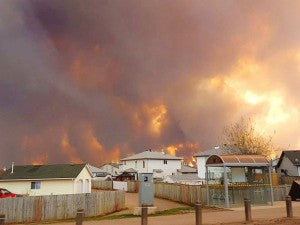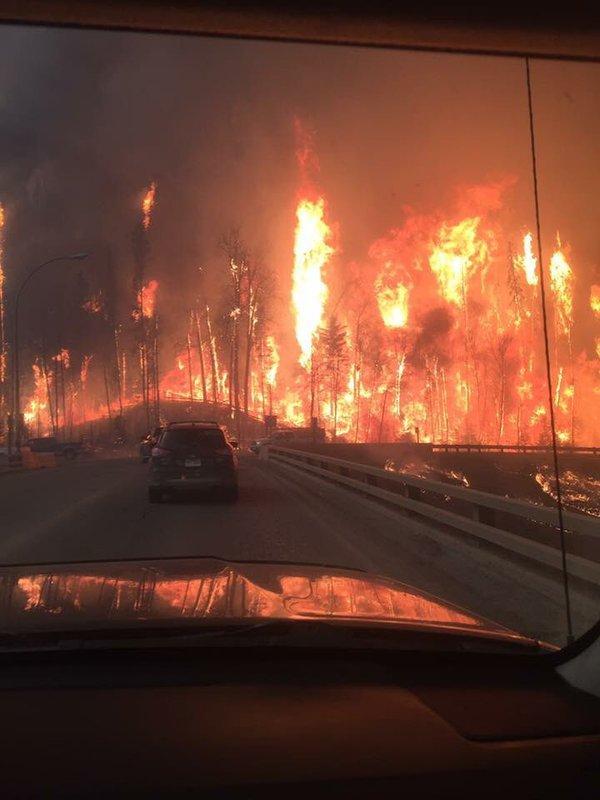 Wildfire along highway 63 Fort McMurray, Alberta Canada May 3, 2016. Courtesy CBC News/Handout via REUTERS[/caption]
Fires raged through Fort McMurray, a city in northeastern Alberta, Canada. The pine trees, once green, burned like candles. The entire city – over 80,000 people – was evacuated. What will become of their homes is left up to fate. After burning for days, the fire has destroyed at least one neighborhood and caused severe damage in others. Fortunately, there have been no reports of deaths or injuries.
The Fort McMurray fire started on Sunday, May 1, 2016, and was declared under control on July 5, 2016. Because of hot weather, low humidity, and strong winds, the raging fire has been difficult to contain. The only way in and out of town is the city’s lone bridge spanning the Athabasca River. Officials have marked that as a high priority to protect.
Without that bridge, nobody is getting in or out, and that includes supplies.
After subduing the fire somewhat, the winds shifted, and according to reports, “flames stormed along a ravine and roared into the city and the race was on to get out.” The scene was not far off from something in an apocalyptic movie.
Unfortunately, once the fire picked up, there was little time to get out. That meant evacuating with basically just the clothes on one’s back. One man opened his front door of his house and was greeted by smoke and flames surrounding his neighborhood. He promptly got on his motorcycle, made his way through traffic, and out of Fort McMurray. He took nothing with him.
Wild fires are swift and dangerous. They can escalate without warning, and much of the time – as in this case – leave no time to gather emergency supplies. Being prepared for such unexpected emergencies is crucial. You never know when you’ll need to jump in your car and leave your home and belongings to fend for themselves.
Because you just never know what will happen – or when – it is of vital importance to put an emergency plan together and prepare with essential supplies you will need for any scenario.
72 Hour Kits
First things first. Make sure you have the necessities you need for the first three days of an emergency. Your 72 hour kit should include water, food, sanitation items, gear for warmth, and other personal items specific to your needs. Ensure this bag is in an easy to reach location so you’re not wasting precious moments searching for it. Keeping it in the front hall closet (or similar location) is a good idea.
Fuel
Always keep your vehicle at least half full of gas. If you’re running on empty and have to evacuate, you could be in for quite the ordeal if your car suddenly runs out of gas. This is what happened to many people evacuating during the Fort McMurray fire. According to one report, vehicles were scattered on the sides of the road, some broken down, but some were out of gas. Police officers had to walk up and down the bottle-necked highway with gas cans to help those stranded make their escape.
This example fuels the importance of always being prepared – no matter what. Make it a priority to keep your car at least a half a tank full. Otherwise, if there is a sudden emergency, you might Replace yourself trapped on the side of the road, and in that instance, there may not be kind police officers with extra gas to hand out.
Wildfire along highway 63 Fort McMurray, Alberta Canada May 3, 2016. Courtesy CBC News/Handout via REUTERS[/caption]
Fires raged through Fort McMurray, a city in northeastern Alberta, Canada. The pine trees, once green, burned like candles. The entire city – over 80,000 people – was evacuated. What will become of their homes is left up to fate. After burning for days, the fire has destroyed at least one neighborhood and caused severe damage in others. Fortunately, there have been no reports of deaths or injuries.
The Fort McMurray fire started on Sunday, May 1, 2016, and was declared under control on July 5, 2016. Because of hot weather, low humidity, and strong winds, the raging fire has been difficult to contain. The only way in and out of town is the city’s lone bridge spanning the Athabasca River. Officials have marked that as a high priority to protect.
Without that bridge, nobody is getting in or out, and that includes supplies.
After subduing the fire somewhat, the winds shifted, and according to reports, “flames stormed along a ravine and roared into the city and the race was on to get out.” The scene was not far off from something in an apocalyptic movie.
Unfortunately, once the fire picked up, there was little time to get out. That meant evacuating with basically just the clothes on one’s back. One man opened his front door of his house and was greeted by smoke and flames surrounding his neighborhood. He promptly got on his motorcycle, made his way through traffic, and out of Fort McMurray. He took nothing with him.
Wild fires are swift and dangerous. They can escalate without warning, and much of the time – as in this case – leave no time to gather emergency supplies. Being prepared for such unexpected emergencies is crucial. You never know when you’ll need to jump in your car and leave your home and belongings to fend for themselves.
Because you just never know what will happen – or when – it is of vital importance to put an emergency plan together and prepare with essential supplies you will need for any scenario.
72 Hour Kits
First things first. Make sure you have the necessities you need for the first three days of an emergency. Your 72 hour kit should include water, food, sanitation items, gear for warmth, and other personal items specific to your needs. Ensure this bag is in an easy to reach location so you’re not wasting precious moments searching for it. Keeping it in the front hall closet (or similar location) is a good idea.
Fuel
Always keep your vehicle at least half full of gas. If you’re running on empty and have to evacuate, you could be in for quite the ordeal if your car suddenly runs out of gas. This is what happened to many people evacuating during the Fort McMurray fire. According to one report, vehicles were scattered on the sides of the road, some broken down, but some were out of gas. Police officers had to walk up and down the bottle-necked highway with gas cans to help those stranded make their escape.
This example fuels the importance of always being prepared – no matter what. Make it a priority to keep your car at least a half a tank full. Otherwise, if there is a sudden emergency, you might Replace yourself trapped on the side of the road, and in that instance, there may not be kind police officers with extra gas to hand out.
Listen Pay attention to what’s going on around you. If you know there is a big fire nearby, keep tabs on it. The man who left his home with just his motorcycle received a phone call from a family member warning him to leave. That’s when he opened his door, saw the flames, and rode away. We are uninformed as to his situation, and perhaps there was a reason he didn’t know the fire had come so close, but this scenario helps hit home the need to monitor emergency situations. Because you never know when the heat will get cranked up and you need to run. Also, follow the council of your local officials. If they give the order to evacuate, do so immediately. They have lots of information available to them, and they know better than anyone the dangers involved. It’s just not worth the risk to wait. Emergency Plan Create a plan with your family of important things to remember during an emergency. Who grabs what and what actions to take in certain circumstances would be a good start. Likewise, come up with a few locations to meet up, just in case you aren’t all together at the time of an evacuation. This will help keep your family together during emergencies. Ready.gov has many more ideas for an emergency plan. Clean Up Keep your yard free of highly flammable objects, such as dead grass, leaves, or branches. Clean out those natural fire starters every once in a while so that if a fire does come, your yard won’t be a huge contributor in feeding the flames. [caption id="attachment_20474" align="alignright" width="300"]A pic of what trying to leave Fort McMurray looks like right now pic.twitter.com/ESE7bzPkx1
— chester (@ccccrystal__) May 4, 2016
 Fort McMurray fire closing in - via Edmonton Journal[/caption]
With the massive evacuations up north, we are reminded of what we must do in order to be effectively prepared. While you can’t necessarily protect everything you own, you can at least protect yourself and your family. Things come and go, but life is precious, and by preparing in advance for emergencies (such as earthquakes, drought, or even raging wildfires), we can make sure we are properly prepared for, protected, and comfortable during these times of crisis.
Take time today to go over your family emergency plan. In what areas do you need to improve?
Fort McMurray fire closing in - via Edmonton Journal[/caption]
With the massive evacuations up north, we are reminded of what we must do in order to be effectively prepared. While you can’t necessarily protect everything you own, you can at least protect yourself and your family. Things come and go, but life is precious, and by preparing in advance for emergencies (such as earthquakes, drought, or even raging wildfires), we can make sure we are properly prepared for, protected, and comfortable during these times of crisis.
Take time today to go over your family emergency plan. In what areas do you need to improve?


